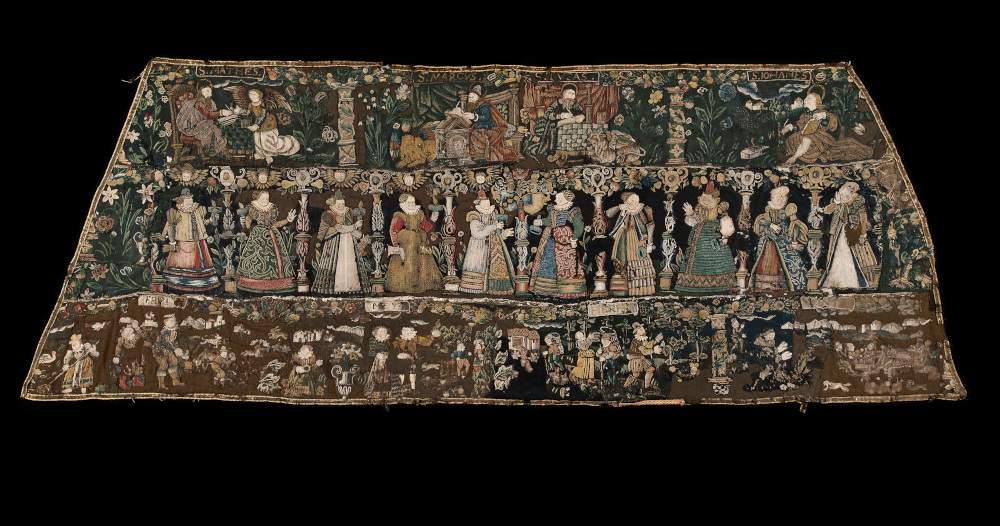Turin, antique textiles from Palazzo Madama's collection return to display in new dedicated room
At Palazzo Madama, more than fifty works from the collection of textiles and fashion will be back on public display from December 21, 2022, in the dedicated room on the second floor. The latter includes about 4,000 artifacts and is among the most important in Italy. The display, which will rotate new works from the collection, will change periodically in order to preserve the proper conservation of the goods.
Coptic fragments in linen and tapestry-worked wool, the oldest in the museum, from Antinoe, a Middle Egyptian city founded by Emperor Hadrian, will be followed by medieval textiles, which document the magnificent production of silk manufactures in the Mediterranean basin and the first important Italian manufacturing centers. For many centuries silk production and processing was a well-protected secret from China, then filtered through Central Asia and Sasanian Iran. It was not until the late 6th century that the silk industry was established in the Byzantine eastern Mediterranean and then spread westward, following Islamic expansion. The precious silk fabrics then reached Christian Europe as diplomatic gifts and entered imperial and papal palaces and cathedral treasuries to protect sacred relics. Between the 12th and 13th centuries silk weaving finally began in Italy, particularly in Venice, Lucca and Florence. Operated Italian velvets, worked with gold and silver yarns, were the most sought-after fabrics by every Renaissance court. Two remarkable examples of them are on display at Palazzo Madama: a Venetian crimson cloth cut in two heights, historically known as high-low, and a large fragment of red silk and gold spun velvet with the characteristic late 15th-century design of thistle flowers, formerly part of a liturgical robe.
Three important artifacts illustrate theart of embroidery in the sixteenth century: a tablecloth depicting the Four Continents, attributed to the Milanese embroiderer Caterina Cantoni, who became famous among her contemporaries for her refined double-right and professional embroidery technique, whose work was coveted by courts throughout Europe; a tablecloth worked in Italy, but in the domestic sphere, decorated with poetic mottos of love and a repertoire of fine polychrome designs of putti, dolphins, manufedes, and rampant lions; and finally, an embroidery depicting the parable of the Wise Virgins and the Foolish Virgins, embroidered in silk on a wool ground with the clothes of women in German-speaking Switzerland in the late 16th century.
Furnishing cloths and clothing fabrics are placed side by side in the room’s historical showcases and tell the story of changing decorative taste over the centuries, with a particular focus on theclothing and style of the eighteenth century, when byzarre, lacy, island, and meandering motifs followed one another rapidly, following the fashion dictated by Paris and Lyon manufactures.
Among these textiles, displayed in the halls of the Civic Museum between the last decades of the 19th and the early 20th centuries, many were reproduced in those years by Italian textile manufacturers, in particular the Turin-based Guglielmo Ghidini factory. Founded in 1865, 20 years later Guglielmo Ghidini, Fabbrica di seterie e broccati d’oro, had a factory at Barriera di Casale and employed more than three hundred workers. In the new display, Palazzo Madama is exhibiting some of the fabrics that reproduce models from its collection, to remind us of the role that the Civic Museum, a museum of applied art in industry, really played towards the city’s manufacturing activities.
A selection of garments, ranging from the 17th century to the 1920s, is displayed from the collection of fashion clothes and accessories. Some of them have undergone restoration and study in recent years. The reopening of the room is an opportunity to see an embroidered joust with the knots of the House of Savoy, the only seventeenth-century garment, now preserved, that can be referred to the house with certainty; anandrienne made from a very rich Lyon lampas prior to the mid-eighteenth century; an Empire-style women’s dress made of very light silk gauze; and two Charleston-style dresses of Milanese tailoring. Also on display for the first time is a banyan, men’s house dress, in silk painted in China and made in Europe in the third quarter of the eighteenth century. It is presented with a miniature velvet habit embroidered with flowers and several men’s accessories in a showcase setting.
In contrast, a dress from the latter years of the same century, which was repurposed to suit the new needs of a new mother and be comfortable for nursing, approaches the theme of reuse.
Image: Cloth. Switzerland, Schaffhausen (1580-1600; cloth and wool diagonal embroidered in wool and gold thread). Gift of Maria Luigia Visconti Venosta 1889; Turin, Palazzo Madama
 |
| Turin, antique textiles from Palazzo Madama's collection return to display in new dedicated room |
Warning: the translation into English of the original Italian article was created using automatic tools. We undertake to review all articles, but we do not guarantee the total absence of inaccuracies in the translation due to the program. You can find the original by clicking on the ITA button. If you find any mistake,please contact us.





























